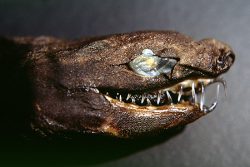select your film:


The Viper Dogfish was first identified in 1986. They are rare deep sea sharks and have been found in the Pacific Ocean off the coasts of Japan, Taiwan and Hawaii.
They migrate vertically in the ocean. At night, viper dogfish swim at between 300 m to 400 m underwater and during the day they will swim closer to the surface at 150 m.
Biology and Behaviour
There is very little known about viper dogfish since they are rarely seen.
Viper dogfish have a large number of photophores on their underside and a smaller number around their bodies which allows them to glow. Their dermal denticles, which are v-shaped scales, make their skin tough and allow them to swim away quickly and quietly.
Viper dogfish capture their prey by extending their jaws and have needle-like teeth. They mainly feed on bony fish, but can consume prey half their size. Scientists revealed the stomach contents of these sharks where they most likely swallow their prey whole.
Male viper dogfish can grow to 47 cm, while female viper dogfish reach 53 cm from head to tail.
Reproduction and Lifespan
Viper dogfish are ovoviviparous.
Conservation and Tourism
The IUCN lists viper dogfish as data deficient because there is little known about their population.
Do you have images or videos of Viper Dogfishs?
Submit them to [email protected].
